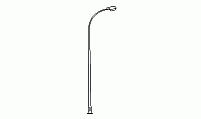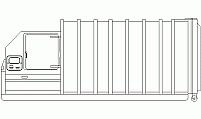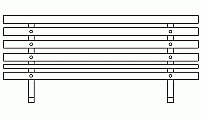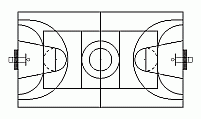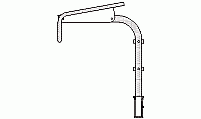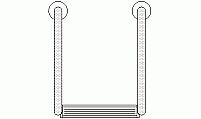CAD Blocks categories
 3D models
3D models home furniture
home furniture sanitary ware - bathrooms
sanitary ware - bathrooms professional equipment
professional equipment doors and windows
doors and windows people and animals
people and animals plants and trees
plants and trees vehicles - transports
vehicles - transports architectural details
architectural details mechanical - electrical
mechanical - electrical urban planning - civil works
urban planning - civil works safety health construction
safety health construction accessible design
accessible design drawing sheet
drawing sheet signals
signals construction machinery
construction machinery accessories and objects
accessories and objects maps and street maps
maps and street maps
Public Playground Structure CAD Block in Top View

size: 13 kb
category: street furniture
related categories:
description: Top-down CAD block of a modular public playground structure featuring climbing nets, multi-level platforms, interactive game zones, and a rectangular access path.
file extension: .dwg CAD - AutoCAD software
Technical Details and Safety Standards for Playground Structures
Modular Design Features of Playground Structures
This playground structure is a modular system designed for children’s play areas in public parks. It includes multiple components, such as climbing nets, interactive panels, and access paths. The central area features two square-mesh climbing zones, made from durable materials like rubber or specialized climbing ropes, which provide flexibility and safety for users.
On the left, a rectangular pathway serves as an access route, while the right side contains an interactive zone with eight circular elements for games or educational activities. The multi-level platforms and climbing areas encourage physical activity and motor skill development. This type of structure is ideal for fostering both fun and learning in a secure environment.
Dimensions and Standard Sizes for Playground Systems
Playground structures vary in size depending on their intended age group and location. Climbing nets are typically 8 to 10 feet (2.4 to 3 meters) tall, with square mesh openings measuring 12 inches (30 cm) for safe gripping. Platforms are usually placed at heights between 24 inches (61 cm) and 48 inches (122 cm), ensuring accessibility for younger children.
The interactive zone on the right typically features elements with diameters of 12 inches (30 cm), suitable for tactile or visual games. Pathways and access areas are at least 36 inches (91 cm) wide, meeting accessibility standards. These dimensions align with guidelines from organizations like ASTM International (US), CSA (Canada), and EN 1176 (Europe).
Safety Standards and Guidelines for Playground Use
Playground equipment must comply with safety regulations to minimize risks. In the US, ASTM F1487 provides standards for the design and safety of public playground equipment, while Europe follows EN 1176. These standards specify maximum fall heights, proper use of impact-absorbing surfaces, and equipment spacing to avoid entrapment.
Key safety measures include the use of shock-absorbing materials like rubber mulch or foam mats beneath climbing areas and interactive zones. The recommended clearance between equipment components is 72 inches (1.8 meters) to prevent collisions. All edges should be rounded, and ropes or nets must support at least 200 pounds (90 kg) to avoid breakage.
Materials and Maintenance for Long-Lasting Playgrounds
- What materials are commonly used?
- Playground structures often use powder-coated steel for frames, UV-resistant plastic for panels, and weatherproof ropes for climbing nets. These materials ensure durability and resistance to outdoor conditions.
- How are playgrounds maintained?
- Routine inspections for loose bolts, frayed ropes, and surface damage are essential. Cleaning surfaces and replacing worn parts prolongs the equipment’s lifespan and ensures safety.
- Are these materials eco-friendly?
- Many manufacturers use recycled materials for plastic components and sustainably sourced wood for additional elements, aligning with green building practices.
Benefits of Interactive and Modular Playground Design
Interactive playground elements, such as the eight circular game panels, promote cognitive and social development by encouraging collaboration and problem-solving. Modular designs allow for customization, enabling parks to adapt the structure for specific themes or age groups.
These systems also maximize space efficiency, as multi-level platforms and climbing zones provide diverse play opportunities within a compact footprint. The combination of interactive and physical challenges supports a holistic approach to childhood development, blending fun with education in outdoor environments.
Evolution and Global Trends in Playground Design
The concept of playgrounds has evolved significantly over the decades. Early designs prioritized functionality over aesthetics, with simple metal structures dominating public spaces. Today, modern playgrounds blend innovative designs with safety and inclusivity, incorporating multi-functional elements like climbing nets, interactive panels, and themed modules.
Globally, playground trends now emphasize sustainability and eco-friendliness. Recycled materials, renewable energy integration, and adaptive designs for different age groups are increasingly common. In Asia, playgrounds often incorporate cultural motifs, while in Europe and North America, inclusive play elements cater to children of all abilities. This global shift highlights the importance of play in fostering creativity, social interaction, and physical health.




















